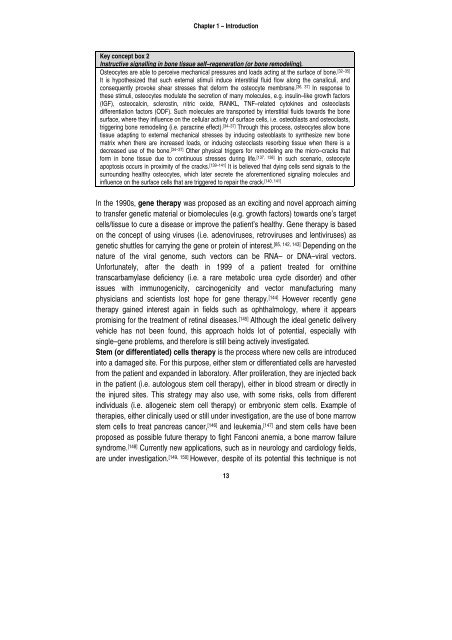Barbieri Thesis - BioMedical Materials program (BMM)
Barbieri Thesis - BioMedical Materials program (BMM)
Barbieri Thesis - BioMedical Materials program (BMM)
Create successful ePaper yourself
Turn your PDF publications into a flip-book with our unique Google optimized e-Paper software.
Chapter 1 – Introduction<br />
Key concept box 2<br />
Instructive signalling in bone tissue self–regeneration (or bone remodeling).<br />
Osteocytes are able to perceive mechanical pressures and loads acting at the surface of bone. [32–35]<br />
It is hypothesized that such external stimuli induce interstitial fluid flow along the canaliculi, and<br />
consequently provoke shear stresses that deform the osteocyte membrane. [36, 37] In response to<br />
these stimuli, osteocytes modulate the secretion of many molecules, e.g. insulin–like growth factors<br />
(IGF), osteocalcin, sclerostin, nitric oxide, RANKL, TNF–related cytokines and osteoclasts<br />
differentiation factors (ODF). Such molecules are transported by interstitial fluids towards the bone<br />
surface, where they influence on the cellular activity of surface cells, i.e. osteoblasts and osteoclasts,<br />
triggering bone remodeling (i.e. paracrine effect). [34–37] Through this process, osteocytes allow bone<br />
tissue adapting to external mechanical stresses by inducing osteoblasts to synthesize new bone<br />
matrix when there are increased loads, or inducing osteoclasts resorbing tissue when there is a<br />
decreased use of the bone. [34–37] Other physical triggers for remodeling are the micro–cracks that<br />
form in bone tissue due to continuous stresses during life. [137, 138] In such scenario, osteocyte<br />
apoptosis occurs in proximity of the cracks. [139–141] It is believed that dying cells send signals to the<br />
surrounding healthy osteocytes, which later secrete the aforementioned signaling molecules and<br />
influence on the surface cells that are triggered to repair the crack. [140, 141]<br />
In the 1990s, gene therapy was proposed as an exciting and novel approach aiming<br />
to transfer genetic material or biomolecules (e.g. growth factors) towards one’s target<br />
cells/tissue to cure a disease or improve the patient’s healthy. Gene therapy is based<br />
on the concept of using viruses (i.e. adenoviruses, retroviruses and lentiviruses) as<br />
genetic shuttles for carrying the gene or protein of interest. [85, 142, 143] Depending on the<br />
nature of the viral genome, such vectors can be RNA– or DNA–viral vectors.<br />
Unfortunately, after the death in 1999 of a patient treated for ornithine<br />
transcarbamylase deficiency (i.e. a rare metabolic urea cycle disorder) and other<br />
issues with immunogenicity, carcinogenicity and vector manufacturing many<br />
physicians and scientists lost hope for gene therapy. [144] However recently gene<br />
therapy gained interest again in fields such as ophthalmology, where it appears<br />
promising for the treatment of retinal diseases. [145] Although the ideal genetic delivery<br />
vehicle has not been found, this approach holds lot of potential, especially with<br />
single–gene problems, and therefore is still being actively investigated.<br />
Stem (or differentiated) cells therapy is the process where new cells are introduced<br />
into a damaged site. For this purpose, either stem or differentiated cells are harvested<br />
from the patient and expanded in laboratory. After proliferation, they are injected back<br />
in the patient (i.e. autologous stem cell therapy), either in blood stream or directly in<br />
the injured sites. This strategy may also use, with some risks, cells from different<br />
individuals (i.e. allogeneic stem cell therapy) or embryonic stem cells. Example of<br />
therapies, either clinically used or still under investigation, are the use of bone marrow<br />
stem cells to treat pancreas cancer, [146] and leukemia, [147] and stem cells have been<br />
proposed as possible future therapy to fight Fanconi anemia, a bone marrow failure<br />
syndrome. [148] Currently new applications, such as in neurology and cardiology fields,<br />
are under investigation. [149, 150] However, despite of its potential this technique is not<br />
13





